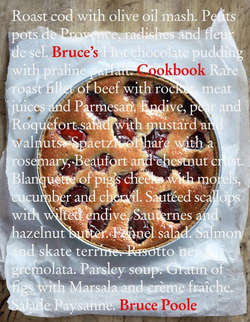Читать книгу Bruce’s Cookbook - Bruce Poole - Страница 29
ОглавлениеOnion tart
This spectacularly good tart featured on our opening menu in February 1995. For some bizarre and rather pretentious reason, I used to call it: Tarte à l’oignon; spécialité d’Alsace. What a mouthful. Well, the tart is actually, and a wonderful mouthful at that. Maybe I thought customers might be more likely to order it if they could identify its origins with a particular part of France and, as my food was definitely based on regional French food at the time, it seemed logical to advertise its authentic provenance. Anyway, I am glad to say that I have jettisoned the silly title, but the tart remains a frequent visitor to our menu. This is most definitely one of my top-ten favourite things of all time to cook and to eat.
Serves 10–12
8 large onions, peeled
250g unsalted butter
1 bunch of fresh thyme, leaves picked, stalks discarded
salt and freshly ground black pepper
9 medium egg yolks
750ml double cream
For the pastry
350g plain flour
scant 1 tsp salt, or a good pinch
225g unsalted butter, cold and diced
60ml iced water
1 medium egg yolk, beaten
Make the pastry. Put the flour into a large mixing bowl and mix in the salt. Rub in the diced butter until the mixture resembles breadcrumbs. Add the iced water and bring the whole lot to a dough with some swift kneading movements. Don’t overwork the dough. Form it into a slightly flattened ball, wrap in clingfilm and refrigerate for at least a few hours or preferably overnight.
Roll out the pastry on a lightly floured surface to a thickness of about 3mm. Use to line a 30–32cm (2cm in depth) tart ring and leave to rest for about 1 hour. Blind bake. When the tart shell is fully cooked, using a pastry brush, paint beaten egg yolk around the interior of the shell and return it to the oven for 30 seconds or so just to seal the shell.
Halve the peeled onions and slice them very finely. Take the knife right through the root so that none of the onion is wasted. The finished tart will slice more elegantly if the onions are prepared carefully at this stage, so take time to do this well. In a large pan, melt the butter over a medium heat and add the onions together with the thyme leaves. Cook, stirring occasionally, for 30 minutes until the onions visibly start to wilt and change colour. Turn the heat down to its lowest setting and continue to sweat the onions, uncovered, for about a further 45 minutes to 1 hour, stirring frequently. The onions will have taken on a deep golden colour and the butter should resemble oil and will be separating out from the onions at the bottom of the pan. Season the onions really well with salt and pepper. Taste the onions – they should be sweet, savoury and delicious. Tip them into a colander and drain off the cooking fat thoroughly. This will seem like overkill on the butter front, but a lot is needed to cook the onions properly. It is also (rather extravagantly) discarded at the end of the cooking process and not consumed in the tart itself.
Set the oven to 150°C.
In a large mixing bowl, lightly beat the egg yolks and add the cream. Season this well with salt and pepper. Add the cooked onions and mix really well. Check the seasoning and adjust if necessary – good seasoning is essential to the success of this tart. With a ladle, add the onion mixture to the cooked tart shell and fill the tart right to the very top. Transfer carefully to the oven and cook for half an hour. Turn the oven down to 130°C and continue to bake until the tart is cooked and the filling has set without a trace of wobble – about a further 15 minutes depending on the dimensions of your tart ring. Leave to rest for at least 1 hour before trimming off the excess pastry overhang.
Remove the ring and slice with a very sharp, serrated knife. This is brilliant as it is, but dressed green leaves, roasted walnuts and Lancashire cheese also make a fine addition to the plate. Real men do eat quiche, by the way.
